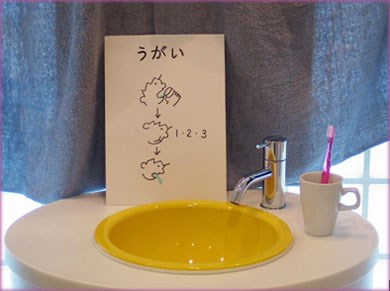Japan - Visual Support Material for Children with Autism in order to Master Toothbrushing Skills
Japan - Visual Support Material for Children with Autism in order to Master Toothbrushing Skills
Hiromi Takaine*, Setsuko Ikeda*, and Yoko Muto*
* Sunstar Foundation for Oral Health Promotion, 3-1 Asahimachi, Takatsuki, Osaka 569-1134, Japan

Japan map from the word factbook
Introduction
Children with autism are susceptible to oral diseases such as dental caries and periodontal disease partly because of the difficulty in mastering the skills required for routine toothbrushing. As visual support has been used successfully to help such children master life skills, a set of picture cards showing the toothbrushing procedure were developed and evaluated if it benefits children with varying degrees of autism.
Background
Majority Japanese primary schools which provide education for 7 to 12 years olds, have separate classes for children with special needs. Children with mild autism usually study in a regular class and those with moderate autism study in a special class.
This programme was carried out in Osaka, Japan. Children who participated in this programme lived with their parents and were attending primary schools.
Programme Outline
- Nineteen children aged ? to 12 with mild to moderate autism participated in this programme.
- Each set of self-toothbrushing instructional cards consisted of 14 picture cards.

Picture cards for self-toothbrushing. The first card (upper left) indicates the start of toothbrushing and the last (lower right) indicates the end. The pictures in between show the step-by-step procedures. The last card (picture of a cup) connects to the drawing in Fig. 2.
- A separate picture sheet was made showing how to rinse the mouth after toothbrushing.

Written instructions for rinsing the mouth after toothbrushing in conjunction with drawings.
- The first card, which showed the start, and the last, which indicated the end of toothbrushing, included verbal expressions. The rest showed the steps of the toothbrushing procedure in pictures.
- For rinsing instructions, three steps were shown on the sheet in picture form.
- Children used the former by turning up the cards and the latter by following the drawings in order.
- Instruction was given by dental hygienists in the school, under the supervision and advice of the children's caregivers, schoolteachers, dentists and experts in developmental disabilities.
Achievements
- After 12 months, 17 of 19 children had mastered toothbrushing skills and continued to brush their own teeth.
The time taken to master these skills varied depending on the features of each individual, especially his or her degree of mental impairment. - The present study indicated that additional ideas were also helpful:
Use of a hand mirror. A large mirror at the washstand sometimes had an adverse effect because it could act as a stimulus. - Singing a song near the child whilst brushing his or her teeth.
- Face-to-face toothbrushing movements.
- Use of the child's favourite toothbrush and toothpaste as he or she may be particular about design or taste.
- Massage around the mouth before toothbrushing.
Conclusion
The toothbrushing picture cards and the rinsing sheets are useful tools in helping some children with autism master the necessary skills.
Acknowledgements
The authors thank Prof. I. Morisaki (Osaka University) and Prof. N. Niizawa (Baika Women's University) for their guidance. This research was funded by a grant from the 8020 Promotion Foundation.
References
1. National Institute of Dental and Craniofacial Research, National Institutes of Health. Practical oral care for people with autism. Accessed 12 November 2009 at: http://www.nidcr.nih.gov/OralHealth/Topics/DevelopmentalDisabilities/PracticalOralCarePeopleAutism.htm
2. Ogata K. (Ed.). Visual behavior guidance in dentistry for persons with special needs-Concepts and practice. Tokyo, Japan: Ishiyaku Publishers, Inc., 2008
